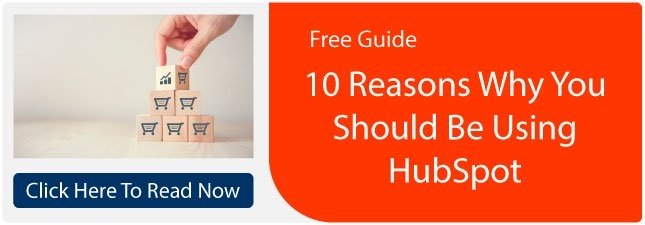

If you've read much about marketing, you've no doubt heard about lead scoring. Lead scoring is absolutely vital to maximizing the efficiency of your sales staff. In this post, we'll answer the question, “What is lead scoring?” Then, we’ll look at some of the ways that HubSpot can help you automate and improve the process by using the vast amount of data it collects about your leads and conversions.
For sales staff, time is money. Every second spent trying to sell to a lead that is unlikely to buy is a second that isn't spent selling to one that will. During the course of business, these seconds add up to a lot of lost opportunities. For that reason, businesses use various data points gathered about a lead to determine how likely that lead is to buy a product or service. Rating the leads in this way is called lead scoring. Let's take a look at some traditional ways that companies manage lead scoring.
Before better options came along, the most common way to score leads was with a handcrafted algorithm specific to a given business. 'One size fits all' algorithms simply do not work for lead scoring because no two customer bases are alike. Because of this, companies take a look at some important distinctions between what makes a good lead and what makes a bad lead. We'll take a look at how they figure that out later. But for now, let's look at what the type of information used to score leads may be.
Every good marketer has developed a buyer persona or a full set of them. A buyer persona is a fictionalized representation of a company's average customer. If you are selling school supplies for elementary kids, your buyer persona is likely to be a parent or the legal guardian of a young child.
It would be a waste of time to have your salespeople try to sell to someone who does not have a child. This is a very simple example of the types of demographic checks you can perform during lead scoring. But it's a clear example of how a lead's demographics can be used to prune down the list to likely candidates.
This is especially true for B2B businesses. In most cases, your ideal customers will belong to a specific industry, have a specific business size, or even cater to their own specific type of customer. Any information you have about the types of businesses most likely to buy something from you is exactly the type of thing that should weigh into your lead scoring decisions.
There are two major ways a lead can interact with you that can give you clues about how likely they are to purchase something. The first is their behavior on your website. Are customers who go on to make purchases more likely to have downloaded an offer from your website? What pages do leads who buy commonly visit that aren't visited by leads who don't buy? How does your bounce rate figure in? Any behavior that can be credibly attached to the likelihood of making a purchase is a prime candidate for including in your lead scoring algorithm.
The second type of interaction worth looking at is their interactions with you. Do leads who click on links in promotional emails or on social media posts convert at a higher rate than those who don't? Does the likelihood increase if they interact with you in more than one way? What effect does it have on conversion rates if a lead likes or shares your social media posts more frequently? All of these things should increase the likelihood of conversion. But how much of an effect each has will be unique to each business.
Once the criteria that will be used to score leads are determined, the algorithm to calculate the score must be created. The purpose of the algorithm is to weight each criterion so that it matches its actual influence. This is calculated in a three-step process:

So far, we've seen a lot of processes that require quite a bit of manual effort. If this was a once and done sort of thing, that might not be too bad. But a good lead scoring algorithm will adapt to changes, which means that yours should be updated regularly. It should come as no surprise that HubSpot, whose entire business model is built around automating complex tasks, have built tools into their software that will help you perform lead scoring more quickly and accurately. Let's look at some of the ways it can help.
At best, automation of traditional scoring without a tool like HubSpot involves using a spreadsheet. You might even write a custom coded program to do the calculations for you. These are still going to rely heavily on manual entry and refinement. As such, these processes hardly qualify as automation at all. HubSpot, on the other hand, already stores all the data you could possibly need about your leads. It allows you to tell it which of those criteria you'd like to use for lead scoring. From there, it will do the work for you.
Traditional scoring is all well and good if you know exactly which criteria you should be using to score leads. But even if you think you do, you probably don't. There are almost always little patterns and correlations that humans don't detect, but big data and machine learning will. This is where HubSpot's predictive scoring comes in. It will take all the data it has collected about your leads and how well they convert. Then the tool will combine that with powerful predictive learning algorithms. It will generate a lead score that is far more accurate than one that comes from human guesswork.
In the early days of your business, one buyer persona is likely enough to represent your customer base. As that customer base grows and your range of offerings grows with it, there will almost certainly be more than one type of person buying your products. HubSpot will allow you to track multiple scoring sheets. You can get scores for each of your buyer personas individually. Since HubSpot is also your CMS, you can even have it show different web content to different leads based on scoring criteria.
Manual lead scoring can be a huge time saver for sales staff. But it relies on a lot of guesswork and involves a fair amount of work itself. HubSpot can help remove the guesswork and automate the processes, making for a much more streamlined lead scoring experience. If you have questions about lead scoring in HubSpot or other ways the software can help your business, please do not hesitate to contact us.
Eniture Technology specializes in helping e-Commerce merchants grow by providing useful information, digital marketing services, off-the-shelf apps that solve common problems, and custom programming services. If you're interested in accelerating the growth of your online sales, please contact us. You might also enjoy this free information on the 10 reasons why you should be using HubSpot to grow your e-commerce business.

GET IN TOUCH
Phone: 404.369.0680
info@eniture.com
320 W. Lanier Avenue
Suite 200
Fayetteville, GA 30214
© 2015 Eniture LLC. All rights reserved.